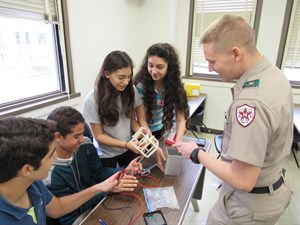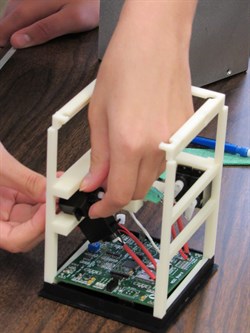 Two years ago undergraduate students in the Dwight Look College of Engineering at Texas A&M University took on the challenge of designing, developing, delivering and supporting a unique embedded intelligence system capable of monitoring, controlling, recording and reporting experiments run in the micro-gravity environment onboard the International Space Station (ISS).
Two years ago undergraduate students in the Dwight Look College of Engineering at Texas A&M University took on the challenge of designing, developing, delivering and supporting a unique embedded intelligence system capable of monitoring, controlling, recording and reporting experiments run in the micro-gravity environment onboard the International Space Station (ISS).
Since then the NASA Extreme Science Program, the Center for the Advancement of Science in Space (CASIS) National Design Challenge and a number of other research institutes have used the Nanoracks Embedded System Interface (NESI+) for experiments conducted on the ISS.
 Students participating in the National Design Challenge from the Houston area recently watched as Orbital Sciences CRS Flight 3, which had their experiments onboard, explode seconds after liftoff from the Mid-Atlantic Regional Spaceport at the Wallops Flight Facility in Wallops Island, Virginia.
Students participating in the National Design Challenge from the Houston area recently watched as Orbital Sciences CRS Flight 3, which had their experiments onboard, explode seconds after liftoff from the Mid-Atlantic Regional Spaceport at the Wallops Flight Facility in Wallops Island, Virginia.
The students were notified by CASIS that they would be given another opportunity to fly their experiments, and four teams made the decision to shoot for the SpaceX 7 launch scheduled for June of this year. Although not providing the embedded systems for the original experiments, Aggie undergraduates supported the teams through mentoring and subject matter expertise. Based on this interaction, CASIS and the teachers asked if the redo of their experiments could include the NESI+ system and the support of the Aggie undergraduates.
One of the outreach sessions hosted by the engineering students brought the teachers and their students to campus for a one-day workshop. The workshop helped to ensure that all of the experiments, schedule to fly on SpaceX-7, were ready for fit testing at NanoRacks in Houston.
“Having programs like this provides a great opportunity for young men and women to learn more about engineering at Texas A&M University while giving our best and brightest undergraduates leadership experience,” said Dr. Jay Porter, program coordinator for the Electronic Systems Engineering Technology (ESET) program.
The ESET program is now participating in a number of other CASIS National Design Challenges including working with teams in Denver, Chicago and Boston.